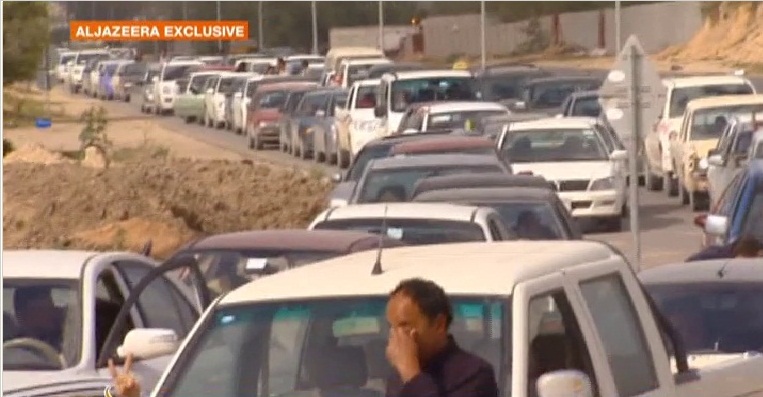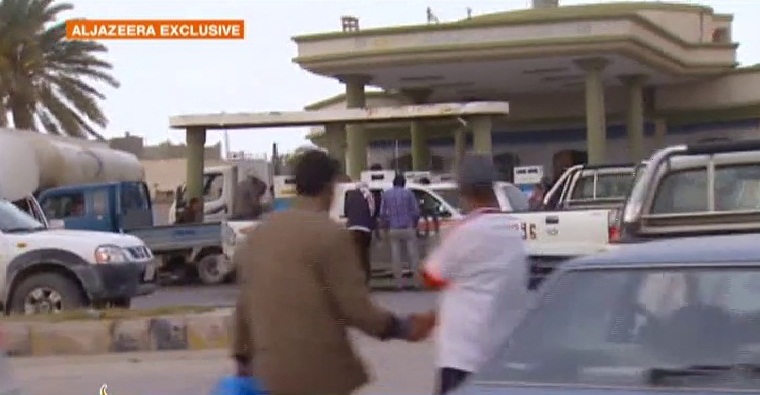This is a classical example of a negative feed back loop of peak oil. Armed conflicts about the 2nd half of oil reduce oil production more than oil-geology.
In its April 2011 oil market report the IEA assessed the battle lines between Gadaffi and opposition forces on this map:
“Attacks by Colonel Gaddafi’s forces on oil producing fields and infrastructure in the rebel‐held eastern region in early April has raised the spectre that the country’s oil production will be offline indefinitely while the civil war rages on….
Libya’s output plummeted by an average 935 kb/d to only 450 kb/d in March, but production is now thought to be completely shut‐in following three separate attacks by government forces on rebel‐controlled oilfields in the eastern region of the country. Previously, only Libya’s ports and storage tanks in the oil towns of Es Sider and Ras Lanuf had been damaged during the two‐month long conflict. A spokesman for the Gaddafi regime refuted the claims, saying the damage had been inflicted by NATO forces. The opposition group meanwhile said the strikes targeted production in a bid to halt further exports from the eastern region.
The attacks targeted oil infrastructure at the country’s largest field, Sarir, in the Sirte Basin, as well as oilfields in the Waha and Messla areas. The three fields were producing around 100 kb/d, down sharply from the 420 kb/d seen before hostilities erupted in late‐February….
The attacks were likely in retaliation for the opposition’s first export of crude to international markets. The rebel‐led Transitional National Council appeared to have navigated around the three different sets of sanctions imposed by the UN, EU and the US. It was hoped that crude exports would provide a steady flow of funding for the rebels. The vessel Equator left Tobruk on 6 April carrying around 1.0 mb of Sarir/Messla crude and was believed to be destined for China, though it is still unclear who the buyer was….
The complete production shut‐in has temporarily stalled hopes of further exports from rebel‐held territories until security can be improved to encompass a much broader area. Damage to storage and other terminal infrastructure can usually be repaired in short order but restarting more complex and aging oil fields and related infrastructure could take many months, depending on the extent of the damage. Agoco, which early on in the conflict formally split off from the overnment‐controlled parent company in Tripoli, said it planned to move forces to the desert region to protect the fields, but it is a vast area to cover with limited resources, and has sparked fears that the Gaddafi regime will employ a scorched‐earth strategy similar to the one Saddam Hussein implemented on his retreat from Kuwait.”
The BBC reports (excerpts):
Tripoli witness: rioting, fighting and dying for fuel
State television announced that as of today – Thursday – we may only have fuel for the amount of 5 dinars ($4), no more, no less.
It has instructed stations to stamp car registration papers with the date of purchase because we can now only refuel every three days or more.
The only official explanation for the shortage has been that, while there is a surplus of petrol, some people are panic buying and others want everyone else to think there is a fuel shortage and are creating long queues to trigger chaos.
My friend successfully re-fuelled his car on Tuesday after three long days and nights in a queue at the petrol station in his area. Resilience and planning are key. He and his brother queued in shifts – they would alternate every three hours during the day and every five hours at night.
“One night a massive fight broke out. People took out knives and others phoned their relatives telling them to come help with the fight. It quickly spiralled out of control. At least three people were stabbed and we heard that one of them later died from his wounds. There have been similar incidents at many other stations.”
“On one day some cars tried to create a second queue. The brigade forces threatened them, shot into the air and shouted. Some left and others stayed.
“Twenty minutes later several cars arrived filled with civilians resembling criminals. They had chains and metal bars and immediately attacked the cars that had refused to leave
“They smashed the windshields, mirrors and hoods and then got into their cars and disappeared as quickly as they appeared. The security forces just watched.”
On Tuesday morning at a petrol station in Abu Nawas on Gergaresh road, “there was a drive-by shooting targeting the queue. Two people were killed. The cars were white Chevrolets”, another friend tells me.
On Saturday night a friend witnessed a shooting on Sidi Masri road.
“A fuel tanker, parked on the side of the road, was illegally filling a few cars with petrol. There were a few brigade men securing the perimeter as this took place.
“A car carrying two men pulled over close by, on the opposite side. One man got out, crossed over and started video-recording with his phone. The security forces saw him and called out: “You! What are you doing?”
“He started running away and they shot him. We saw him fall. Immediately the car he came in drove off. There was a taxi near them – the driver was probably working for internal security because they told him to follow the car and he sped off in pursuit. The man who was shot was picked up and thrown into the brigade force truck. They drove off with him.”
http://www.bbc.co.uk/news/world-africa-13222425
A glimpse into the future of Mad Max?
Previous posts on Libya:
12/4/2011 Libyans fight over oil field at depletion mid point while African crude oil exports decline
http://www.crudeoilpeak.com/?p=2947
24/3/2011 Libya: yet another (peak) oil war
http://www.crudeoilpeak.com/?p=2759
24/2/2011 Libya exports 7% of crude from Mediterranean and Middle East
http://www.crudeoilpeak.com/?p=2633
23/2/2011 Quick primer on Libyan oil
http://www.crudeoilpeak.com/?p=2621


